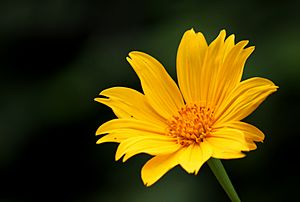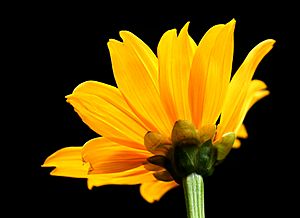Tithonia diversifolia facts for kids
Quick facts for kids Tithonia diversifolia |
|
|---|---|
 |
|
| Tithonia diversifolia flower | |
 |
|
| Reverse (flower) | |
| Scientific classification | |
| Genus: |
Tithonia
|
| Species: |
diversifolia
|
| Synonyms | |
|
|
The Tithonia diversifolia is a type of flowering plant in the Asteraceae family. It's often called the tree marigold, Mexican sunflower, or Japanese sunflower. This plant comes from Mexico and Central America. Now, you can find it in many warm parts of the world because it was introduced there.
Depending on where it grows, it can be an annual plant (grows for one year) or a perennial plant (grows for many years). This plant is very good at making soil healthier. It helps soil that doesn't have many nutrients. Farmers, especially in Africa, have found it to be a cheap way to make their crops grow better. It can increase important soil nutrients like nitrogen (N), phosphorus (P), and potassium (K).
Contents
What Does the Mexican Sunflower Look Like?
The Tithonia diversifolia plant can grow quite tall, usually about 2 to 3 meters (6.5 to 10 feet) high. It has strong, upright stems that can become woody like a shrub.
Its flowers are big and bright yellow or orange. They can be 5 to 15 centimeters (2 to 6 inches) wide. The leaves are large, about 10 to 40 centimeters (4 to 16 inches) long. They often have 3 to 7 lobes, like fingers, and feel a bit rough. The plant's seeds are small, about 5 millimeters long, and are spread by the wind. The leaves grow on alternating sides of the stem. This is why it's called "diversifolia," which means "different leaves." The plant can grow all year round. Its seeds spread by wind, water, and even animals.
Where Does the Mexican Sunflower Come From?
This plant first grew in Mexico. From there, it spread to other parts of Central and South America. It also moved north into the United States. Later, people brought it to parts of Africa and Asia. They used it as a pretty garden plant. However, it grew very quickly and became a widespread plant that grows where it's not wanted.
You can often find it growing in areas that are 550 to 1950 meters (1,800 to 6,400 feet) above sea level. It commonly grows along rivers and roadsides. In Asia and Latin America, it has other names. For example, it's called kembang bulan in Indonesia and jalacate in Spanish.
How People Use the Mexican Sunflower
The Mexican sunflower has many interesting uses around the world.
- In Japan, people brought it as an ornamental plant a long time ago. It has a bitter taste. People used it to cause a fever, which they thought helped fight poisoning. It's also said that Nitobe Inazo introduced it to Japan. That's why its Japanese name is the Nitobe chrysanthemum (ニトベギク; Nitobegiku).
- It is the official symbol of Da Lat city in Vietnam.
- You can find it sold in herbal medicine markets in Taiwan.
- It is also the provincial flower of Mae Hong Son Province in Thailand.
Using the Plant as a Natural Fertilizer
One of the most important uses of T. diversifolia is as a green fertilizer for farmers. It can also be used for other things like chicken feed, firewood, or to stop soil from washing away. For fertilizer, farmers can spread the plant's leaves and stems on top of the soil. They can also bury it under the soil. Using this plant as a fertilizer has been shown to help crops grow much better.
T. diversifolia is especially good at putting phosphorus back into the soil. As a fertilizer, it contains good amounts of nitrogen (1.76% N), phosphorus (0.82% P), and potassium (3.92% K). These amounts are often higher than what you find in regular animal manure.
Growing Conditions for the Mexican Sunflower
The Tithonia diversifolia plant can grow in many different environments. It can handle some dry weather. It grows best in places that get about 1000 to 2000 millimeters (40 to 80 inches) of rain each year. The ideal temperature for it is between 15 and 31 degrees Celsius (59 to 88 degrees Fahrenheit).
This plant doesn't need a lot of nutrients to grow. This is because it can actually increase the important nutrients in the soil itself. Since it spreads quickly, farmers can easily get large amounts of it to use as fertilizer.
Economic Benefits for Farmers
Studies have shown that using this green fertilizer can help farmers earn more money. For example, one study looked at tomato plants. It found that using Tithonia diversifolia helped increase the amount of tomatoes grown. This meant more income for the farmers.
However, it's important to think about the work involved. Another study found that for crops like maize (corn), the amount of work needed might not be worth the money gained. This is especially true in places where rain is unpredictable. This study also found that growing T. diversifolia on the farmer's main crop land might not be the best idea. It's often better to collect the plant from another area and bring it to the fields.
In one study, fields that only received a phosphorus fertilizer made about $50 USD per hectare. But when only T. diversifolia was used, the income went up to $494 USD per hectare! Other studies have shown smaller, but still good, increases in income.
How to Use the Plant as Fertilizer
Tithonia diversifolia can be used as a natural fertilizer. This means using parts of the plant, like its leaves and stems, and mixing them into the soil. Because it takes a lot of work to use this plant as fertilizer, it's best for crops that are worth a lot of money. These include tomatoes, kale, carrots, and maize.
Farmers can grow the plant in hedges around the edges of their fields. This way, it doesn't take up space where their main crops grow. Farmers can cut the green stems, leaves, and flowers from the plant. It's suggested that cutting the plant every 5 months gives the most nutrients.
The plant material can also be used as a mulch. This means leaving it on top of the soil to break down. T. diversifolia breaks down quickly and releases its nutrients fast. When applying it, farmers should use at least one ton of plant material for every hectare of land. However, the best results come from using 5 tons per hectare. The challenge is that a lot of plant material is needed for a small area because it contains a lot of water.
Mixing this plant material with other fertilizers can lead to even better crop yields. One study found that using Tithonia with a fertilizer called triple superphosphate (TSP) increased yields by 220% compared to using only a nitrogen fertilizer. When using T. diversifolia, it's a good idea to add a magnesium fertilizer too, as this nutrient might be lower in Tithonia compared to some other green fertilizers.
Images for kids
See also
 In Spanish: Tithonia diversifolia para niños
In Spanish: Tithonia diversifolia para niños


